Call Us
+86 136 6007 9809
Call Us
+86 136 6007 9809
Nov. 19, 2024
Industry solutions for loose fastener threaded connections
Loosening of fastener screw and nut threaded connections is a common form of failure. Loosened threaded connections tend to have greater torque and axial force attenuation, and the attenuated axial force does not ensure a reliable threaded connection. It can even be accompanied by slippage of the connected parts and bolt fracture.
Therefore, when the threaded connection is loosened, the necessary failure analysis should be carried out to prevent the same position from failing again. So, in what ways and how should a loose-threaded connection be analyzed?
01 Qualitative analysis
The loosening of threaded connections can be divided into two categories. One is rotational loosening, that is, between the internal and external threads occurred in the direction of loosening the relative rotation of the loosening occurs; the other is non-rotational loosening, that is, the internal and external threads did not occur when the relative rotation of the loosening occurs. Then, how do we determine whether it is rotational loosening or non-rotational loosening?
You can use the color marking method for discrimination in the bolt tightening, in the bolt head, and in the connection contact position to draw a colorful color marking. After testing the bolt loosening, observe the head of the bolt and the color marking on the connected parts, whether in a line. If they are not in a line and have shifted, rotational loosening has occurred; if the color scale is still on a line, non-rotational loosening has occurred.
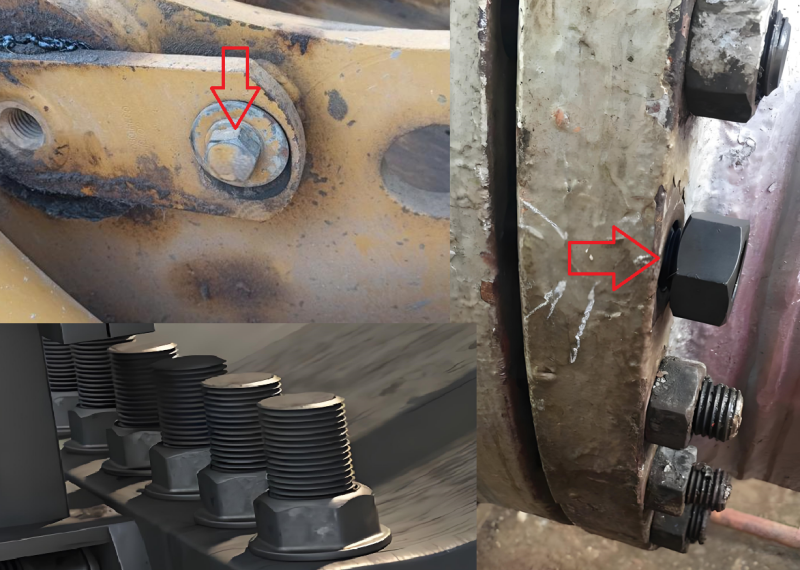
02 Rotational loosening analysis
When determining whether a threaded connection results from rotational loosening through qualitative analysis, deciding on the specific cause is necessary; first, test the relevant parts (such as friction coefficient, size, etc.) to confirm whether they meet the requirements of the design drawings. If there is no problem after the test, it means that the cause of rotational loosening is that the preload of the bolt tightening is not enough to resist the external load. Then, consider the idea from the pre-tightening force and external load.
2.1 Insufficient preload
The solution of insufficient preload: increasing the utilization rate of bolts, increasing the torque of bolt assembly can increase the utilization rate of bolts and increase the assembly preload; in addition, changing the torque method into the corner method can also effectively increase the assembly preload and preload accuracy; increase the size and grade of bolts, using larger size bolts and higher grade bolts can effectively increase the assembly preload, but the assembly torque should be raised accordingly.
2.2 Size and form of external loads
When the external load is large, the assembly preload can not effectively resist the external load, resulting in rotational loosening. On the premise that the test results of the parts meet the design requirements, the external load on the threaded connection can be reduced by optimizing the design of the connection structure.
Load forms: The primary external loads on threaded connections are torsional, shear, and axial. Rotational loosening is the most sensitive to shear load, torsion load is second, and axial load is unaffected. Therefore, the design should avoid or reduce the size of the shear load as much as possible, and the location of the shear load can be appropriate to increase the friction coefficient between the connected parts.
#Socket Head Screws
#Alloy Steel Socket Head Screws,
#Hex Drive Rounded Head Screws,
#Pan Head Phillips Screws,
#Extra-Wide Truss Head Phillips Screws,
#Decorative Round Head Phillips Screws,
#Narrow Cheese Head Phillips Screws,
#High-Profile Narrow Fillister Head Phillips Screws,
#Pan Head Slotted Screws
#Narrow Cheese Head Slotted Screws
#Decorative Round Head Slotted Screws
#High-Profile Narrow Fillister Head Slotted Screws
#Low-Profile Ultra-Wide Truss Head Slotted Screws
#Extra-Wide Truss Head Slotted Screws
#Torx Rounded Head Screws
#Combination Phillips/Slotted Rounded Head Screws
#Flanged Rounded Head Screws
#Rounded Head Screws with Lock Washer
#Thread-Locking Rounded Head Screws
#Wire-Lockable Rounded Head Screws
#Tamper-Resistant Rounded Head Screws
#Sealing Rounded Head Screws
#Left-Hand Threaded Rounded Head Screws
#High-Strength Grade 8 Steel Hex Head Screws
#High-Strength Grade 8 Steel Flanged Hex Head Screws
#Stainless Steel Flanged Hex Head Screws with Slotted Drive
#High-Strength Grade 8 Steel Thread-Locking Hex Head Screws
#Hex Head Screws with Flat Washer
#Hex Drive Flat Head Screws
#Phillips Flat Head Screws
#Phillips Oval Head Screws
#Torx Flat Head Screws
#Slotted Flat Head Screws
#Slotted Oval Head Screws
#Tamper-Resistant Flat Head Screws
#Sealing Flat Head Screws
#Vibration-Resistant Flat Head Screws
#Vented Flat Head Screws
#Left-Hand Threaded Flat Head Screws
#Rounded Head Screws for Sheet Metal
#Extra-Wide Rounded Head Screws for Sheet Metal
#Decorative Rounded Head Screws for Sheet Metal
#Tamper-Resistant Rounded Head Screws for Sheet Metal
#Flanged Rounded Head Screws for Sheet Metal
#Rounded Head Screws with Washer for Sheet Metal
#Flat Head Screws for Sheet Metal
#Hex Head Screws for Sheet Metal
#Blunt Screws for Sheet Metal
#Strip-Resistant Screws for Sheet Metal
#Screws for Joining Sheet Metal to Wood
#Piercing Screws for Sheet Metal
#Drilling Screws for Metal
#Thread-Cutting Screws for Metal
#Thread-Forming Screws for Metal
#Tapping Screws for Plastic
#Tapping Screws for Concrete, Block, and Brick
#Tapping, Drilling, and Wood Screw Assortments
#General Purpose Shoulder Screws
#Low-Profile Precision Shoulder Screws
#Metric Thread-Locking Precision Shoulder Screws
#Cup-Point Set Screws
#Locking Cup-Point Set Screws
#Vented Cup-Point Set Screws
#Flat-Tip Set Screws
#Soft-Tip Set Screws
#Oval-Tip Set Screws
#Extended-Tip Set Screws
2.3 Anti-loosening design
If the optimization cost of preload and external load is high, it can be optimized from the angle of the anti-loosening design. The most common anti-loosening design has bolts with pre-coated anti-loosening glue. The use of self-locking nuts, etc., can effectively avoid rotational loosening.
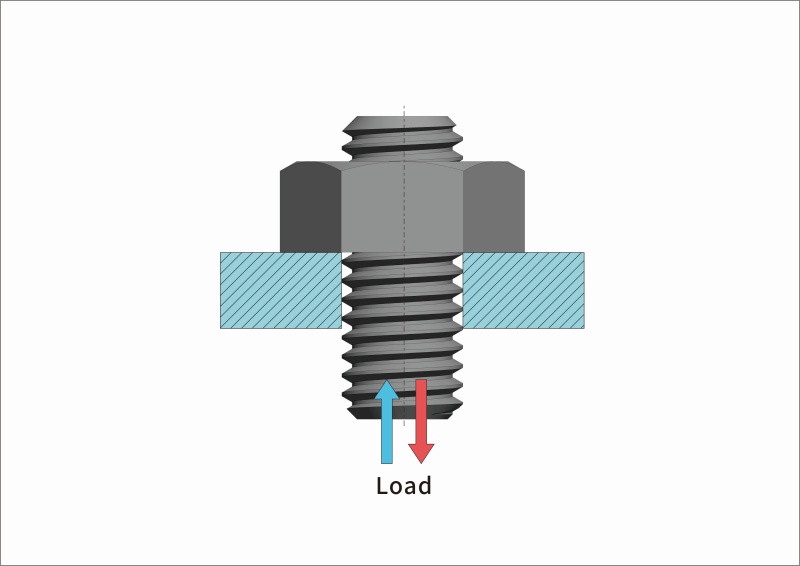
03 Non-rotational loosening analysis
Non-rotational loosening is another form of loosening, which is mainly manifested in the absence of relative displacement between the inner and outer threads. However, there is a significant loss of preload and torque in the assembly. Then, the idea of analysis can be considered from the following directions.
3.1 Connectors working at high temperatures
High temperatures lead to non-rotational loosening, which can be considered thermal expansion and stress relaxation.
Thermal expansion:
When the bolt and connected part's coefficients of thermal expansion are different, the bolt's axial force changes when the coupling system's temperature changes after the bolt is tightened. The axial force may become larger or smaller depending on the differences in the connecting parts and fasteners. Therefore, for fasteners and connected parts with significant differences in coefficients of thermal expansion, it is necessary to consider whether this factor is the cause of non-rotational loosening.
Stress relaxation:
Fasteners are already stretched when the assembly is completed, and if high temperatures are applied, creep reduces the amount of stretch and, thus, the preload. This process of creep in a pre-fastener is called stress relaxation. The reduction in axial stress reduces the preload of the fastener. The amount of load loss due to stress relaxation is often a critical consideration in many applications where bolted connections are required to withstand high-temperature loads.
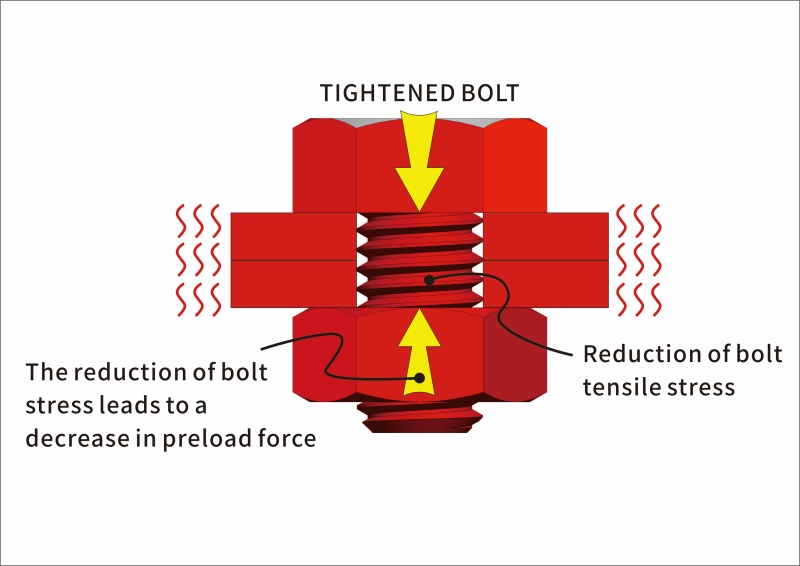
3.2 Soft connections
Soft connections, i.e., connections with an angle greater than 720° from the start of tightening to reach the target torque, have a high torque and axial force decay and are prone to loosening and failure after thread tightening. Therefore, soft connections should be avoided as much as possible in the design and manufacture. For example, the existence of plastic rubber connectors in the connection vice, poor matching of the bonding surface (the existence of gaps, poor flatness, surface roughness, multi-plane matching), significant gaps in the weldments, large gaps in the open gear structure parts, and insufficient length of the bushing.
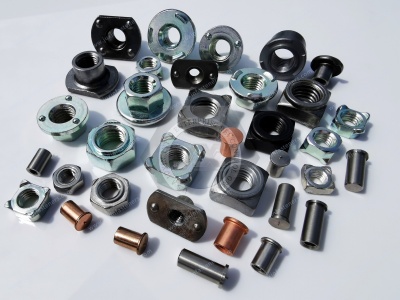
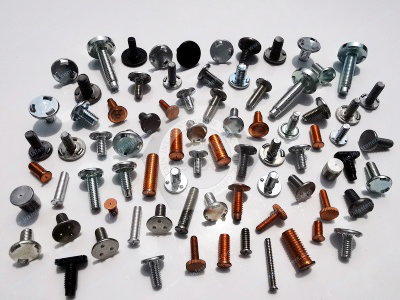
3.3 Connection surface roughness
The contact surface between the nut and the fastener, the contact between two fasteners, and the contact surface between the bolt and the fastener are not entirely smooth; after being subjected to alternating loads, the non-smooth surface will become smooth due to friction, which will lead to the thinning of the clamping thickness of the connected parts as shown in the following figure on the right. The reduction of the thickness of the clamped parts corresponds to the amount of attenuation of the axial force. Therefore, the roughness of the individual contact surfaces should be minimized to avoid gaps between the connected parts.
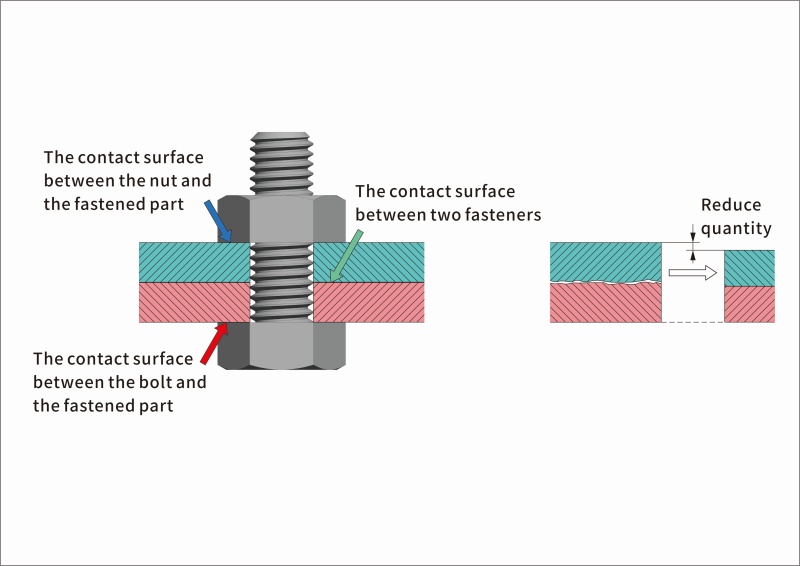
3.4 Collapse of connected parts
The fasteners used for tightening are usually heat-treated, with a yield strength of 640 MPa (8.8-grade bolts) or more and high hardness, while the yield strength of the connected parts is generally lower than that of the fasteners. When the tightening torque is high, the connected surfaces may deform plastically, resulting in collapse, as shown in the figure below. Because the clamping length of the connected parts decreases, the axial force and torque decay.
By using washers or flange bolts, the contact area between the screw and the fastened part is increased; the strength and stiffness of the connected part is increased.
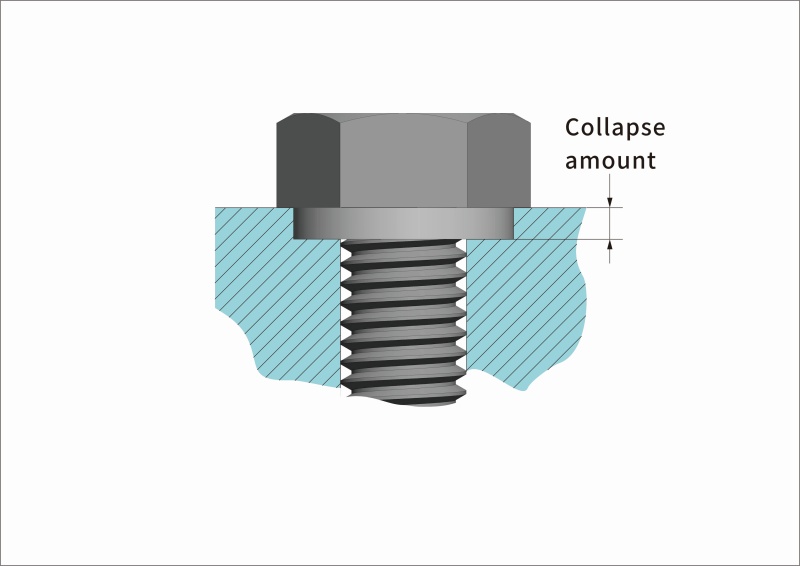
3.5 Optimization of the bolt connection structure
As shown in the figure below, the connection structure of slender bolts is favorable for both rotational loosening and non-rotational loosening, and short, thick bolts are unfavorable in preventing loosening. Longer bolts require greater external loads for loosening to occur; at the same time, the stiffness of the bolts and the connection being made decreases, which reduces the relaxation coefficient of the connecting pair and decreases the susceptibility to loosening.
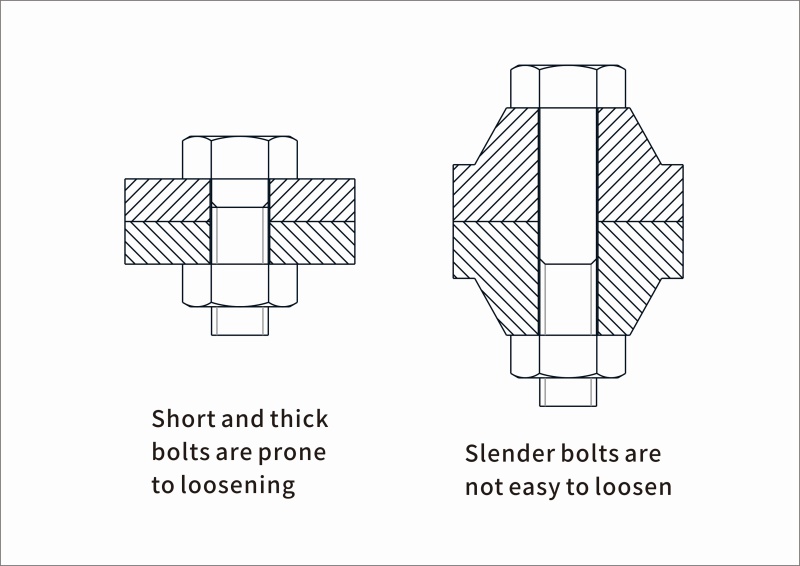
Specific measures to optimize short thick bolts into thin bolts are as follows: adding bushings, thinning the bolt stem, eliminating part of the internal thread (countersinking), etc., as shown in the figure below.
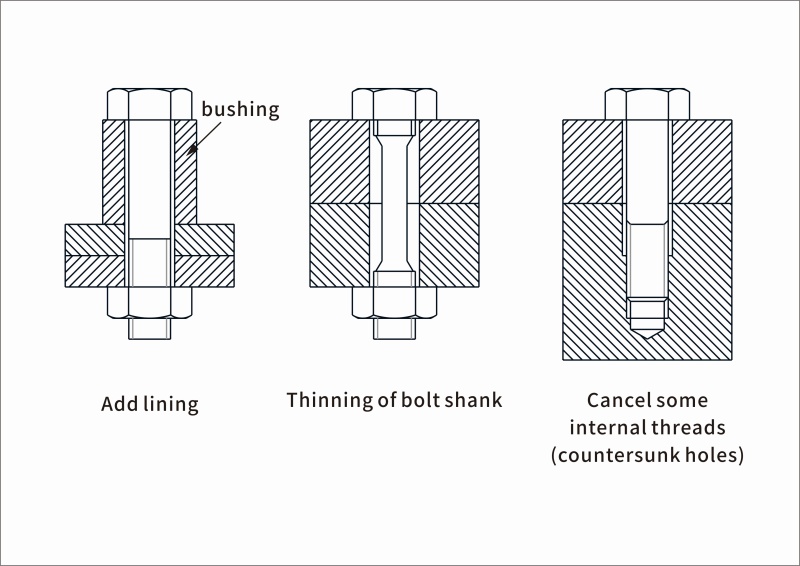
Email:adelajonly@gmail.com
https://www.juxinfasteners.com/screws-and-bolts-weld-screws-blots/
WhatsApp:+86 13660079809
Contact Us
Tel.:
+86 020 8621 0320
+86 020 3121 6067
Technical Support:
Navigation
SEND INQUIREY